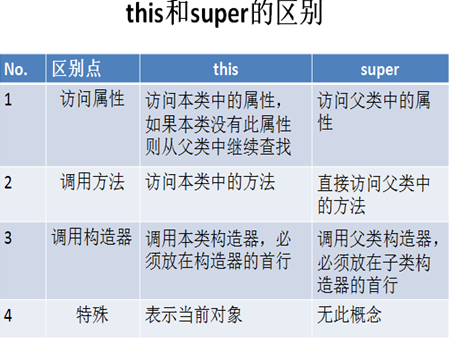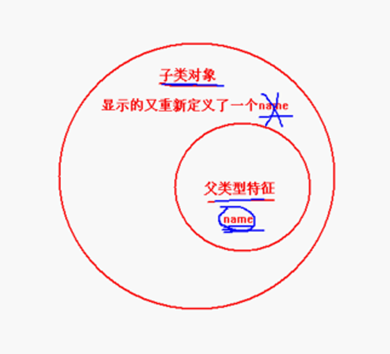2.3 super关键字
①super不是引用类型,super中存储的不是内存地址,super指向的不是父类对象.
②super代表的是当前子类对象中的父类型特征。
③什么时候使用super?
类和父类中都有某个数据,例如,子类和父类中都有name这个属性。如果要再子类中访问父类中的name属性,需要使用 super.
④super可以用在什么地方?
>super可以用在成员方法中,不能用在静态方法中。
> super可以用在构造方法中。
⑤super关键字用在构造方法中:
语法:
|
super(实参); |
作用:通过子类的构造方法去调用父类的构造方法.
语法规则:一个构造方法第一行如果没有this(...);也没有显示的去调用super(...);系统会默认调用super();
⑥注意:
>super(...);的调用只能放在构造方法的第一行; super(....)和this(....)不能共存。super(...);调用了父类中的构造方法,但是并不一定会创建父类对象。在java语言中只要是创建java对象,那么Object中的无参数构造方法一定会执行。
>尤其当子父类出现同名成员时,可以用super进行区分;super的追溯不仅限于直接父类; super和this的用法相像,this代表本类对象的引用,super代表父类的内存空间的标识。
⑦单例模式缺点:单例模式的类型无法被继承
super用在成员方法中:
|
//员工 public class Employee{ String name = "张三";
//成员方法 public void work(){ System.out.println("员工在工作!"); } } |
|
//经理 public class Manager extends Employee{ String name = "李四"; //子类将父类中的work方法重写了. public void work(){ System.out.println("经理在工作!"); } //成员方法 public void m1(){ //this.work(); //work();
super.work();
System.out.println(this.name); System.out.println(name); System.out.println(super.name); } /* //this和super相同,都不能用在静态上下文中。 public static void m1(){ System.out.println(super.name); } */ } |
super用在构造方法中:
|
//账户 public class Account extends Object{ //Field private String actno; private double balance; //Constructor public Account(){ //super(); System.out.println("Account的无参数构造方法执行!"); } public Account(String actno,double balance){ //super(); this.actno = actno; this.balance = balance; } //setter and getter public void setActno(String actno){ this.actno = actno; } public String getActno(){ return actno; } public void setBalance(double balance){ this.balance = balance; } public double getBalance(){ return balance; } } |
|
public class DebitAccount extends Account{ //Field //独特属性 private double debit; //Constructor public DebitAccount(){ //super(); } public DebitAccount(String actno,double balance,double debit){ //通过子类的构造方法去调用父类的构造方法,作用是:给当前子类对象中的父类型特征赋值。 super(actno,balance);
this.debit = debit; } //setter and getter public void setDebit(double debit){ this.debit = debit; } public double getDebit(){ return debit; } } |
|
public class Test02{
public static void main(String[] args){
DebitAccount da = new DebitAccount();
} } |
单例模式的类无法被继承
|
//单例模式的类型没有子类。无法被继承. //父类 public class Servlet{
//构造方法私有 private Servlet(){} } //子类 class HttpServlet extends Servlet{ } |

